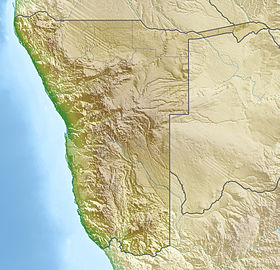geo.wikisort.org - Coast
Cape Cross (Afrikaans: Kaap Kruis; German: Kreuzkap; Portuguese: Cabo da Cruz) is a headland in the South Atlantic in Skeleton Coast, western Namibia.[1]
| Cape Cross | |
|---|---|
 Cape Cross Cape fur seal colony | |
| Location | Erongo Region, Namibia |
| Coordinates | 21°46′18.84″S 13°57′21.96″E |
| Governing body | Ministry of Environment and Tourism |
History

In 1484, Portuguese navigator and explorer Diogo Cão was ordered by King John II of Portugal to advance south into undiscovered regions along the west coast of Africa, as part of the search for a sea route to India and the Spice Islands. While doing so, he was to choose some particularly salient points and claim them for Portugal by erecting stone crosses called padrão. During his first voyage, thought to have taken place in 1482, he reached a place he called Monte Negro, now called Cabo de Santa Maria, roughly 150 km southwest of today's Benguela, Angola.
During his second voyage, in 1484–1486, Cão reached Cape Cross in January 1486, being the first European to visit this area. He is known to have erected two padrãos in the areas beyond his first voyage, one in Monte Negro, and the second at Cape Cross. The current name of the place is derived from this padrão. What can today be found at Cape Cross are two replicas of that first cross.[2]
Padrão

The original Cape Cross padrão was removed in 1893 by Corvette captain Gottlieb Becker, commander of the SMS Falke of the German Navy, and taken to Berlin. The cross is now held in the Deutsches Historisches Museum. A simple wooden cross was put in its place. The wooden cross was replaced two years later by a stone replica.
At the end of the 20th century, thanks to private donations, another cross, more similar to the original one, was erected at the cape along with the first replica. The inscription on the padrão reads, in English translation:[3]
In the year 6685 after the creation of the world and 1485 after the birth of Christ, the brilliant, far-sighted King John II of Portugal ordered Diogo Cão, knight of his court, to discover this land and to erect this padrão here".
Seal reserve

Cape Cross is a protected area owned by the government of Namibia under the name Cape Cross Seal Reserve. The reserve is the home of one of the largest colonies of Cape fur seals in the world.[4]
Cape Cross is one of two main sites in Namibia (the other is in Lüderitz) where seals are culled, partly for selling their hides and partly for protecting the fish stock. The economic impact of seals on the fish resources is controversial: while a government-initiated study found that seal colonies consume more fish than the entire fishing industry can catch,[5] animal protection society Seal Alert South Africa estimated less than 0.3% losses to commercial fisheries.[6]
References
- "Cape Cross". capecross.org. Archived from the original on 9 June 2018. Retrieved 30 May 2010.
- "Diogo Cão", Encyclopædia Britannica
- "Henties Bay to Palmwag". fuzzytravel.com. Retrieved 26 September 2012.
- "Cape Cross". namibian.org. Archived from the original on 11 February 2010. Retrieved 30 May 2010.
- Weidlich, Brigitte (28 June 2007). "Seal quota down for this season". The Namibian.
- "Time for Namibia to see the tourism value of seals". The Namibian. 17 June 2010. Archived from the original on 17 March 2012.
External links
На других языках
- [en] Cape Cross
[ru] Кейп-Кросс
Кейп-Кросс[источник не указан 2393 дня] (англ. Cape Cross, африк. Kaap Kruis, нем. Kreuzkap) или Крейс[1] — мыс на юго-западном побережье Африки, в Намибии, на расстоянии 1000 миль от южной оконечности материка. Окрестности мыса известны как одно из самых больших в мире лежбищ капских морских котиков, являются заповедником и пользуются популярностью у туристов. Также на мысе расположена точная копия падрана, установленного в 1485 году экспедицией Диогу Кана, португальского мореплавателя, открывшего эти места для европейцев; оригинальный падран, в честь которого мыс и получил своё название (то есть Мыс Креста), хранится в Немецком историческом музее в Берлине.Другой контент может иметь иную лицензию. Перед использованием материалов сайта WikiSort.org внимательно изучите правила лицензирования конкретных элементов наполнения сайта.
WikiSort.org - проект по пересортировке и дополнению контента Википедии
